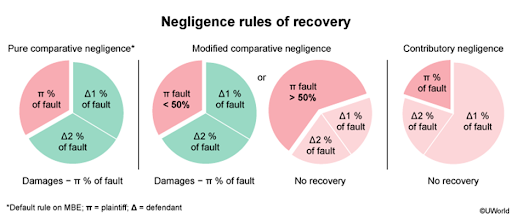Modified Comparative Negligence: All You Need to Know
Contents
- Modified Comparative Negligence: All You Need to Know
- What is Comparative Negligence?
- Why was Modified Comparative Negligence needed?
- Pure Comparative Negligence vs. Modified Comparative Negligence
- Understanding the 50% Rule and 51% Rule
- Modified Comparative Negligence Examples
- Pros and Cons of Modified Comparative Negligence
- Impact of Modified Comparative Negligence on Injury Claims
- If Modified Comparative Negligence applies in your case
- Hiring an Experienced Injury Attorney
- Conclusion and final thoughts
Modified comparative negligence laws are designed to help determine fault in personal injury cases. It is a complex tort principle that can be difficult to understand, especially for those unfamiliar with the legal system.
This post will cover everything you need to know about modified comparative negligence law, including how it works, the different types of modified comparative negligence laws, and how it can impact your personal injury case. Whether you’re a lawyer, a law student, or just curious about the legal system, this post is an excellent resource for anyone looking to understand modified comparative negligence laws better.
What is Comparative Negligence?
Comparative Negligence is a legal concept used to determine who is at fault in a personal injury case. It is a system used in all states in the United States, but the specific rules may vary depending on the state. The basic principle of Comparative Negligence Law is that if more than one party is responsible for a personal injury, each party is responsible for their portion of the damages.
Comparative Negligence allows for a fair and reasonable allocation of responsibility for a personal injury. This system considers that accidents are often not caused by one person alone but rather by a combination of factors. Comparative Negligence allows all parties involved in an accident to be held accountable for their actions and the damages they caused.
Under Comparative Negligence Law, a judge or jury determines each party’s fault percentage. For example, suppose the judge or jury determines that the plaintiff is 20% responsible for the accident and the defendant is 80% responsible. In that case, the plaintiff will only be able to recover 80% of the damages they incurred. This system ensures that all parties involved in a personal injury case are held accountable for their actions and that the injured party is fairly compensated for their damages.
Why was Modified Comparative Negligence needed?
Modified Comparative Negligence was created to respond to the traditional all-or-nothing approach regarding negligence in personal injury cases. Under the old system, if a victim was found even partially at fault for an accident, they were barred from recovering any damages. This was known as contributory negligence, often considered unfair and overly harsh.
Modified Comparative Negligence balances the scales by allowing victims to recover damages even if they were partially at fault for an accident. The law requires that the victim’s percentage of fault be determined, and that percentage will reduce damages. For example, if a victim was found to be 20% at fault for an accident and suffered $100,000 in damages, they could recover $80,000 (the full damages minus 20%).
This system is seen as more equitable, allowing victims to recover damages even if they were partially responsible for the accident. It also encourages responsible behavior, as individuals are less likely to engage in risky behavior if they know they could be held liable for a portion of the damages. Overall, Modified Comparative Negligence Law has been a positive development in personal injury law and has helped ensure that victims receive fair compensation for their injuries.
Pure Comparative Negligence vs. Modified Comparative Negligence
Modified comparative negligence law and pure comparative negligence law are two different types of negligence laws used in different states in the United States. While they both deal with determining liability in personal injury cases, there are some key differences between them.
| Comparative Negligence Rule | Plaintiff’s Recovery | Plaintiff’s Fault Threshold |
|---|---|---|
| Pure Contributory Negligence | Completely barred | Any degree of fault |
| Pure Comparative Negligence | Proportional to fault | No threshold |
| Modified Contributory Negligence | Proportional to fault below the threshold | Threshold is typically 50% or 51% |
Pure comparative negligence allow the plaintiff to recover damages even if they are found to be partially at fault for the accident. The damages awarded are reduced by the percentage of fault attributed to the plaintiff. So if the plaintiff is found to be 30% at fault, then their damages award will be reduced by 30%. States that use pure comparative negligence:
- Alaska
- Arizona
- California
- Florida
- Kentucky
- Louisiana
- Mississippi
- Missouri
- New Mexico
- New York
- Rhode Island
- Washington
On the other hand, the modified comparative negligence is a bit more restrictive. Under this law, the plaintiff can only recover damages if they are found to be less than 50% at fault for the accident. If the plaintiff is found to be 50% or more at fault, they are barred from recovering any damages.

Another key difference between the two laws is how they deal with the damages awarded. In comparative negligence law, the damages award is reduced by the percentage of fault attributed to the plaintiff. In modified comparative negligence law, the damages award is reduced by the percentage of fault attributed to the plaintiff, but only up to a certain point. Once the plaintiff is found to be more than 50% at fault, they are no longer entitled to any damages.
It’s important to understand the differences between these two types of negligence laws if you’re involved in a personal injury case. The law in your state will determine which type of law applies, so it’s important to consult with a qualified attorney to understand your rights and obligations under the law.
Understanding the 50% Rule and 51% Rule
In states that follow modified comparative negligence law, two different rules are used in determining who is responsible for an accident.
50% rule
The first is the 50% rule, which means that a person can only recover damages if they are found to be 49% or less at fault for the accident. This means that if a person is found to be 50% or more at fault for an accident, they will not be able to recover any damages.
51% rule
The second rule is the 51% rule, which means that a person can only recover damages if they are found to be 50% or less at fault for the accident. This means that if a person is found to be 51% or more at fault for an accident, they will not be able to recover any damages.
- Connecticut
- Delaware
- Hawaii
- Illinois
- Indiana
- Iowa
- Massachusetts
- Michigan
- Minnesota
- Montana
- Nevada
- New Hampshire
- New Jersey
- Ohio
- Oklahoma
- Oregon
- Pennsylvania
- South Carolina
- Texas
- Vermont
- West Virginia
- Wisconsin
- Wyoming
It’s important to note that in states that follow modified comparative negligence law, the damages a person can recover will be reduced by the percentage of fault assigned to them. For example, if a person is found to be 20% at fault for an accident and seeks $10,000 in damages, they will only recover $8,000 ($10,000 minus 20%).
Modified Comparative Negligence Examples
Modified Comparative Negligence Law is a complex legal concept that can be difficult to understand without real-life examples. In cases where this law applies, the court will consider the extent to which each party was at fault for the incident. Here are some examples of cases where Modified Comparative Negligence Law may apply:
Personal Injury Claims
If a person is injured due to another party’s negligence, but they were also partially responsible for the accident, the court will take into account the percentage of fault of each party. For example, if a person is hit by a car while crossing the street but they were jaywalking at the time, the court may find that the pedestrian was 30% at fault for the accident and the driver was 70% at fault.
Product Liability Claims
In cases where a person is injured due to a defective product, but they were also using the product in a way that it was not intended to be used, the court may find that the injured party was partially at fault. For example, if a person is injured while using a power tool, but they removed an important safety guard before using the tool, the court may find that the injured party was partially at fault for their own injuries.
Premises Liability Claims
If a person is injured on someone else’s property, but they were also acting in a way that contributed to the accident, the court may find that the injured party was partially at fault. For example, if a person slips and falls on a wet floor in a grocery store but also wears shoes with no traction on the bottom, the court may find that the injured party was partially at fault for the accident.
In all of these cases, Modified Comparative Negligence Law will come into play to determine each party’s fault percentage and how damages will be awarded. It’s important to understand how this law works if you are involved in a personal injury or other type of claim where this law may apply.
Pros and Cons of Modified Comparative Negligence
Modified Comparative Negligence is a legal concept designed to help determine the degree of fault for each party involved in an accident and distribute damages accordingly. However, like any legal concept, it has its pros and cons.
One of the key advantages of Modified Comparative Negligence is that it is a fair way to determine the degree of fault for each party involved in an accident. This means that those most responsible for the accident will be held accountable, while those less responsible will not be penalized as severely.
Another advantage of Modified Comparative Negligence is that it can help reduce the number of frivolous lawsuits. This is because plaintiffs who are partially responsible for their injuries may not be able to collect as much in damages and, therefore, may be less likely to pursue legal action.
However, there are also some disadvantages to Modified Comparative Negligence Law. One of the main drawbacks is that it can be difficult to determine the degree of fault for each party involved in an accident. This can lead to lengthy legal battles, making it difficult for plaintiffs to collect the damages they are entitled to.
Furthermore, some critics argue that Modified Comparative Negligence can be unfair to plaintiffs seriously injured due to an accident. This is because they may be deemed partially responsible for their injuries and unable to collect as much in damages as they would if they were not found to be at fault.
Modified Comparative Negligence is a complex legal concept with pros and cons. While it is designed to be a fair way to determine fault and distribute damages, it is important to weigh the advantages and disadvantages carefully before pursuing legal action under this framework.
Impact of Modified Comparative Negligence on Injury Claims
Modified Comparative Negligence Law a significant impact on personal injury claims. Under this law, a plaintiff’s compensation amount is reduced by a percentage equivalent to their level of responsibility in the accident. This means that if a plaintiff is found to be 25% responsible for their injuries, their compensation amount will be reduced by 25%.
The impact of Modified Comparative Negligence on personal injury claims can be positive or negative, depending on the circumstances. For instance, if a plaintiff is found to be partially responsible for their injuries, but the defendant is also negligent, the plaintiff can still recover some compensation. However, if the plaintiff is found to be more than 50% responsible for their injuries, they may not be entitled to compensation.
If Modified Comparative Negligence applies in your case
Modified Comparative Negligence Law is a complex legal concept that can often be difficult to understand. One of the most important things to consider when determining if this law applies in your case is whether there is any degree of fault on the part of the plaintiff.
Under this law, if the plaintiff is found to be more than 50% at fault for the accident or injury, they are not entitled to compensation. However, if the plaintiff is found to be 50% or less at fault, they may still be entitled to compensation, although their award will be reduced to their degree of fault.
To determine if Modified Comparative Negligence applies in your case, speaking with an experienced personal injury attorney is important. They can review the facts of your case and help you understand your legal rights and options.
Hiring an Experienced Injury Attorney
If you’ve suffered a personal injury and believe you may have a viable claim, hiring an experienced personal injury attorney to represent you in court is extremely important. Modified comparative negligence laws can be complicated and difficult to navigate independently. An experienced attorney will be able to assess the strength of your case and the extent to which you may be at fault, helping you to navigate the legal system and achieve a favorable outcome.
An attorney can also offer valuable advice and guidance throughout the process, including helping you understand your legal rights and obligations, negotiating with insurance companies on your behalf, preparing and filing legal paperwork, and representing you in court if necessary.
Most importantly, an experienced personal injury attorney will ensure that your rights are protected and that you receive fair compensation for your injuries. This can include compensation for medical expenses, lost wages, pain and suffering, and other damages.
While attempting to handle your personal injury claim alone may be tempting, the stakes are too high to go alone. An experienced personal injury attorney can help you achieve the best possible outcome and ensure you receive the justice and compensation you deserve.
Conclusion and final thoughts
Modified Comparative Negligence is a legal principle used to determine the compensation an injured victim can receive in a personal injury case. The law is based on the concept of shared fault, considering the degree of fault of both the plaintiff and the defendant.
In states that follow this law, an injured victim can only recover damages if found to be less than 50% at fault for the accident. If the victim is found to be 50% or more at fault, they may not be able to recover any damages.
It is important to note that the Modified Comparative Negligence Law application varies from state to state. Some states follow a pure comparative negligence system, meaning an injured party can recover damages even if they were more than 50% at fault for the accident.
In any personal injury case, it is crucial to consult with an experienced attorney who can help you navigate the legal system and protect your rights. A skilled attorney can review the facts of your case, determine the degree of fault of all parties involved, and fight to ensure that you receive the compensation you deserve.
We hope you found this article informative and helpful in understanding the modified comparative negligence concept. This law can impact your case in various ways, and it’s important to understand how it works. We encourage you to do further research and seek the advice of a qualified attorney if you have any legal questions or concerns. Thank you for reading, and we hope that this article has helped you gain a better understanding of this complex legal concept.





I recently had a car accident where another driver ran a red light and hit me. At first, it looked like they were totally to blame. But as things were looked into more, it turned out I was a bit over the speed limit at the time.
Texas has this modified comparative negligence rule. It means in an accident, both people can be partly to blame. If you’re more than 50% at fault, you can’t get money for damages. But if you’re less at fault, you can get some money, just less depending on how much at fault you are.
In my case, the court said the other driver was 70% at fault and I was 30% for speeding. So, I could still get money, but 30% less. whatever.
Even though I was bummed to get less money because of my speeding, I get why the law works like this.
My lawyer ended up settling with the other driver’s insurance. They paid me, but considering my part in the accident, it was less than I originally hoped for. Still, I’m thankful I got something and learned a lot.
In a recent personal injury case, a pedestrian was hit by a car while crossing the street. The pedestrian was found to be partially at fault for the accident because they were crossing the street outside of a designated crosswalk. However, the driver of the car was also found to be negligent because they were speeding at the time of the accident.
Under modified comparative negligence laws, the court determined the percentage of fault for each party involved. Let’s say the pedestrian was found to be 30% at fault for crossing outside of the crosswalk, and the driver was found to be 70% at fault for speeding.
In this case, the pedestrian was still able to recover damages for their injuries, but the amount they could receive was reduced by their percentage of fault. So if the total damages were determined to be $100,000, the pedestrian would only be able to recover $70,000 (70% of the total damages) due to their 30% contribution to the accident.
This